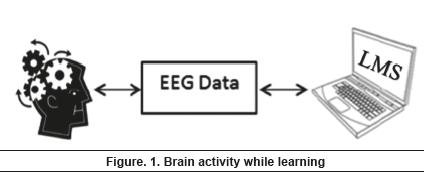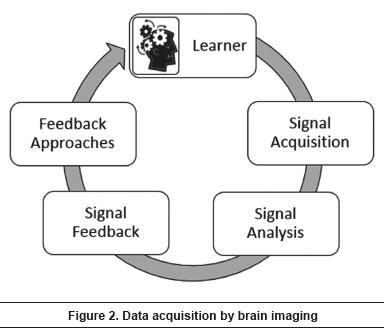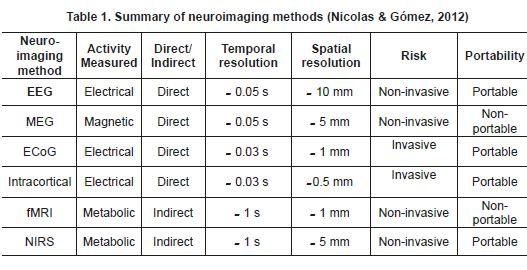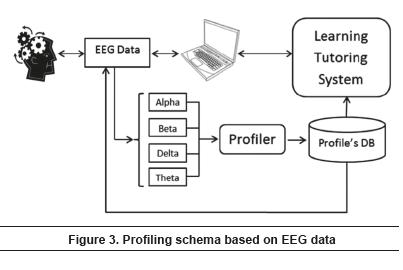Services on Demand
Journal
Article
Indicators
-
 Cited by SciELO
Cited by SciELO -
 Access statistics
Access statistics
Related links
-
 Cited by Google
Cited by Google -
 Similars in
SciELO
Similars in
SciELO -
 Similars in Google
Similars in Google
Share
Revista Lasallista de Investigación
Print version ISSN 1794-4449
Rev. Lasallista Investig. vol.10 no.2 Caldas July/Dec. 2013
Adaptive User Profiling Scheme Using Brain Imaging*
Esquema adaptado de perfilamiento mediante el uso de imágenes cerebrales
Esquema adaptado de perfilhamento mediante o uso de imagens cerebrais
Julián Gaviria Giraldo**, Jovani Alberto Jiménez Builes***
* This work is the result of a master research thesis in Computer Science developed from 2011 to 2012 with the support and sponsorship of Universidad Nacional de Colombia.
** Ph. D. Student of Engineering– Systems and Informatics. Facultad de Minas, Universidad Nacional de Colombia
***Ph. D. Associate Professor, Facultad de Minas, Universidad Nacional de Colombia
Mail: Jovani Arlberto Jiménez Builes, email: jajimen1@unal.edu.co.
Article received: 14/02/2013; Article approved: 01/11/2013
Abstract
Introduction. This article shows how computer science and cognitive neuroscience can be merged to propose an effective profiling scheme. In the area of user profiling this paper will provide the paths and trends that researches has already gone through, and how some issues are being overpassed. In other words, this work will solve effectively one issue: content personalization through the identification of an individual's learning behavior. Objective. This work will demonstrate characterizing someone's brain responses to a specific action is possible. As this research topic has to deal with different fields and there are not previous researches that conveys both. The core idea is to provide enough elements to form the foundations in both areas and propose a scheme to do so. Materials and methods. This section summarizes basic elements of interaction between learners and computers that allows us to integrate them. It will show how some responses named cognitive neuroscience variables are a good source of information for user profiling and will illustrate how this researched field especially used in neuroscience can be effectively used for this purpose. In other words, this paper is going to show the reader how some reactions to exposed actions can be tracked and characterized. Results. It discusses some issues to take into account for developing the proposed profiling scheme and shows how human brain responses can be used to acquire the necessary information to feed an intelligent profiling system. These assumptions allow researchers to account different phenomena and use them for different purposes like the one being developed in this work: Learner Profiling. Conclusiones. Algunas ventajas y desafíos del Perfilamiento de Aprendices se enumeran y se invita a los investigadores a aplicar esta tecnología en otros campos y a ampliar esta aplicación, especialmente en el contexto enseñanza-aprendizaje.
Key words: imaging, learning, user profiling, personalization, neuroimaging, tutoring system.
Resumen
Introducción. Este artículo muestra cómo la ciencia computacional y la neurociencia cognoscitiva pueden fusionarse para proponer un esquema efectivo de perfilamento. En el área de perfilamiento de usuarios, este artículo provee los caminos y tendencias por los cuales ha pasado la investigación acerca del tema, y muestra cómo se han pasado por alto algunos aspectos. En otras palabras, este trabajo resolverá efectivamente un punto: la personalización de contenido a través de la identificación del comportamiento de un individuo en sus procesos de aprendizaje. Objetivo. Este trabajo demostrará que caracterizar las respuestas del cerebro de alguien ante una acción específica es posible. Este tema de investigación tiene que ver con distintos campos y no hay trabajos anteriores que combinen ambos. La idea central es dar suficientes elementos desde las bases en ambas áreas y proponer un esquema para hacerlo. Materiales y métodos. Esta sección resume elementos básicos de interacción entre quienes aprenden y los computadores, que pueden integrarse. Demostrará cómo algunas respuestas conocidas como variables de neurociencia cognoscitiva son una buena fuente de información para perfilar e ilustrará cómo este campo investigativo, especialmente utilizado en neurociencia, puede ser usado efectivamente con este objetivo. En otras palabras, este trabajo mostrará al lector cómo algunas reacciones ante acciones expuestas pueden ser seguidas y caracterizadas. Resultados. Se discuten algunos elementos a ser tenidos en cuenta para desarrollar el esquema de perfilamento y mostrar cómo las reacciones del cerebro humano pueden utilizarse para adquirir la in formación necesaria para alimentar un sistema inteligente de perfilamiento. Estas presunciones permiten a los investigadores contabilizar distintos fenómenos y utilizarlos para objetivos tales como el desarrollado en este trabajo: Perfilamento de Aprendices. Conclusiones. Algunas ventajas y desafíos del Perfilamiento de Aprendices se enumeran y se invita a los investigadores a aplicar esta tecnología en otros campos y a ampliar esta aplicación, especialmente en el contexto enseñanza-aprendizaje.
Palabras clave: imágenes, aprendizaje, perfil del usuario, personalización, neuroimágenes, sistema de tutoría.
Resumo
Introdução. Este artigo mostra como a ciência computacional e a neurociência cognoscitiva podem fusionar-se para propor um esquema efetivo de perfilhamento. Na área de perfilhamento de usuários, este artigo provê os caminhos e tendências pelos quais passou a investigação a respeito do tema, e mostra como se passaram por alto alguns aspectos. Em outras palavras, este trabalho resolverá efetivamente um ponto: a personalização de conteúdo através da identificação do comportamento de um indivíduo em seus processos de aprendizagem. Objetivo. Este trabalho demonstrará que é possível caracterizar as respostas do cérebro de alguém ante uma ação específica. Este tema de investigação tem que ver com diferentes campos e não há trabalhos anteriores que combinem ambos. A ideia central é dar suficientes elementos desde as bases em ambas áreas e propor um esquema para fazê-lo. Materiais e métodos. Esta seção resume elementos básicos de interação entre quem aprendem e os computadores, que podem integrar-se. Demonstrará como algumas respostas conhecidas como variáveis de neurociência cognoscitiva são uma boa fonte de informação para perfilar e ilustrará como este campo investigativo, especialmente utilizado em neurociência, pode ser usado efetivamente com este objetivo. Em outras palavras, este trabalho mostrará ao leitor como algumas reações ante ações expostas podem ser seguidas e caracterizadas. Resultados. Discutem-se alguns elementos a ser tidos em conta para desenvolver o esquema de perfilhamento e mostrar como as reações do cérebro humano podem utilizar-se para adquirir a in formação necessária para alimentar um sistema inteligente de perfilhamento. Estas presunções permitem aos investigadores contabilizar diferentes fenômenos e utilizá-los para objetivos tais como o desenvolvido neste trabalho: Perfilhamento de Aprendizes. Conclusões. Algumas vantagens e desafios do Perfilhamento de Aprendizes se enumeram e se convida aos pesquisadores a aplicar esta tecnologia em outros campos e a ampliar esta aplicação, especialmente no contexto ensino-aprendizagem.
Palavras importantes: imagens, aprendizagem, perfil do usuário, personalização, neuro-imagens, sistema de tutoria.
Introduction
A profile is a description of someone containing the most important or interesting facts about him or her (Schiaffino & Armandi, 2009). Information about a user profile contains essential information about users and their preferences. Determining these preferences will allow a system to provide personalize contents that meet their interest and goals (Huang & Chuang, 2012). Personalized systems only show the users the resulting personalization as this could result in a number of usability and privacy problems (Bakalov et al., 2013). The two most common are hiding user models occludes the system status and hinders control (Nielsen, 1994). At this field, the main contribution is to state an accurate system that can be used at many different areas empowering users and systems to meet their educational needs.
So far, a brain-computer interface (BCI) is a hardware and software communications system that permits cerebral activity alone to control computers or external devices (Nicolas & Gómez, 2012). The BCI usage in research was considered too complex, because of the limited resolution and reliability of information that was detectable in the brain and its high variability and the technology was extremely expensive (Leuthardt et al., 2012). This context has changed radically; nowadays is a flourishing research field with over 100 active groups worldwide.
BCIs use brain signals to gather information on user intentions that can be used to better understand use's expectations (Kanwisher & Moscovitch, 2000). These signals are acquired through electroencephalography. It is by far the most widely used neuroimaging modality, owing to its high temporal resolution, relative low cost, high portability, and few risks to the users.
EEG (Electroencephalogram) signals are easily tracked in a non-invasive manner through electrodes placed on the scalp. It measures electric brain activity caused by the flow of electric currents during synaptic excitations of the dendrites in billions of neurons and is extremely sensitive to the effects of secondary currents (Sitaram, Weiskopf & Caria, 2008).
Materials and methods
Interaction between users and computers such as browsing, reading, listening, seeing, inputoutput device interaction can easily provide information that may be used to extract profiles and show the results.
These actions can be recorded and then to obtain results by applying statistical techniques; another way is to record brain activity produced during those actions. Figure 1 shows how EEG data are produced while learners interact with materials in an LMS (Learning Management System).
Cognitive psychology suggests that information processing in an individual concerns behavior and mental entities, states, processes and provisions of mental nature. According to this assumption, brain activity can be scored while performing some actions, and represent how important each behavior is to the learner. In other words, brain activity can be scored and calculated accurately.
Then a profile can be made and this information could be used in many different ways, for example: the information needed to support a desired learning need and then personalize the content to be delivered based on the generated information into the brain.
This paper is structured as follows: The first section provides an introduction on how these two fields can be merged to propose an effective profiling scheme. Subsequent section summarizes basic elements of interaction between learners and computers that allows us to integrate them. Results sections shows how human brain responses can be used to acquire the necessary information to feed an intelligent profiling system. Next sections will discuss some issues to take into account for developing the proposed profiling scheme. Finally, some conclusions are listed to show advantages and challenges of profiling learners.
Brain imaging information
A brain-computer interface (BCI) is a communication system that relies on the brain rather than the body to provide control and feedback (Song & Epps, 2012).
A BCI, as shown in figure 2, is an artificial intelligence system that can recognize a certain set of patterns in brain signals by following five consecutive stages:
- Signal acquisition, preprocessing or signal enhancement, feature extraction, classification, and the control interface (Sitaram et al., 2008).
- Signal analysis: after an EEG neuroheadset acquires signals from the scalp; the amplifiers process the analog signal to enlarge the amplitude of the EEG signals
- Signal feedback: the A/D converter can digitalize the signal in a more accurate way.
- Feedback approaches: EEG embraces a set of signals, which may be categorized according to their frequency.
- Learner: the recording device, which may be a personal computer or similar, stores, and delivers the data (Pineda, 2005).
Learners-computers interaction
The first stage is the learner-computer interaction in which EEG data are produced and read through an EEG reader device. The signal acquisition stage has to deal with capturing the signals and reducing noise.
The signal analysis stage identifies information in the brain signals, and then those signals are mixed with others to provide feedback to the original signals. After that, some signals approaches are applied to achieve appropriate pattern recognition. Finally, the classified signals are translated into meaningful information that could account a user profile.
There are many different kinds of neuroimaging modalities. The table 1 summarizes the most useful methods, then and explanation about why EEG is most accessible will be provided:
The chosen neuroimaging method for the proposed scheme is EEG. This method measures electric brain activity caused by the flow of electric currents during synaptic excitations of the dendrites in the neurons and is extremely sensitive to the effects of secondary currents (Amiri & Asadpour, 2013). Moreover, it allows systems to record signals easily in a non-invasive manner through electrodes placed on the scalp. However, signals are sometimes poor, making reading noisy; avoiding this issue will be part of further research.
Frequency ranges have been defined according to distribution over the scalp. These frequency bands are referred to as delta (δ), theta (θ), alpha (α), beta (β), and gamma (γ) from low to high, respectively (Übler, 2001). These wavebands can provide useful information related to cognitive processes: from concentration stages and emotions to conscious motor actions.
Results
Brain imaging allows researchers to track brain activity caused by the currents in the dendrites among billions of neurons. (Kinreich et al., 2012).
The figure 3 exemplifies the proposed profiling schema. Three different parts can be appreciated:
EEG data acquisition
Data is acquired through a neuroimaging headset, this set of data is classified into alpha, beta, delta and theta wavebands and then they are sent to the profiler section.
Profiler
The aim of the profiler step in a BCI system is the recognition of a use's intentions on the basis of a feature vector that characterizes the brain activity provided by the feature step.
Either regression or classification algorithms can be used to achieve this goal, but using classification algorithms is currently the most popular approach (Lotte et al., 2007). Users through supervised learning using a labeled data set (Shenoy et al., 2006) have traditionally calibrated classification algorithms.
Profiles DB
It stores profiles' data. It contains historical information about the learner and how a specific profile has changed over the time. This information can then go to different sections, to the EEG section to be compared with the new readings and keep records of those changes, and the learning tutoring system to provide it with enough data for content personalization.
Learning tutoring system
The learning tutoring system will consist of a module attached to an LMS. This module will provide the LMS with the necessary information provided by the profile's DB to personalize contents. In this way, contents will respond accurately to the users' needs. Communication with the user interface is bidirectional to provide feedback related to any change and if necessary changes will be made in real time.
Discussion
Learning services usually provide the same data to all learners. The best scenario would be one where the data suits the learner style. Many different techniques to get users' profile information among the available information in the Internet are being developed. At this field, two main approaches have been addressed (Morita et al, 2006):
- Direct method: Ask users directly to tell us about their interests etc. via a questionnaire or by active selection.
- Indirect method: Record a use's behavior and construct his/her activity history and then automatically identify current interests.
First method is not practical due to the requirement for the user to continuously enter information about himself/herself. The second method involves a scheme in which users' activity can be tracked and historically recorded, then it is analyzed in order to create a profile and transform data that suits his/her needs. This work introduced a scheme that uses an indirect method that is called brain imaging.
Conclusions
User profiling technology has a wide range of usages. It can be used not only as tool that automatically provides information to support marketing and commerce services, but also for quality services such as education. To develop more accurate user profiles, researchers are to be committed to expanding the range of data history and analyzing the information in more detail. I intend to verify the effectiveness of the user profiling technology by applying it to practical learning services.
This approach supports automatic updates of the scheme based on a use's usage history and the semantic structure of the domain knowledge in the learning tutoring model. It also provides the possibility to enable users to update their profiles automatically over the time.
Further work will address and study the implication of using such scheme in different educational models. It will allow researchers to construct systems based on experiences like simulations and to provide them with features that enhance a more meaningful learning process.
References
• Amiri, S.; Fazel-Rezai, R. & Asadpour, V. (2013). A Review of Hybrid Brain-Computer Interface Systems. Advances in Human-Computer Interaction, p. 1-8. doi:10.1155/2013/187024. [ Links ]
• Astaras, A.; Moustakas, N.; Athanasiou, A. & Gogoussis, A. (2013). Towards Brain-Computer Interface Control of a 6-Degree-of-Freedom Robotic Arm Using Dry EEG Electrodes. Advances in Human-Computer Interaction, p. 1-6. doi:10.1155/2013/641074. [ Links ]
• Bakalov, F.; Meurs, M.; König-Ries, B.; Sateli, B.; Witte, R.; Butler, G. & Tsang, A. (2013). An Approach to Controlling User Models and Personalization Effects in Recommender Systems. [ Links ]
• Froschl, C. (2005). User modeling and user profiling in adaptive e-learning systems. Graz, Austria: Master Thesis. [ Links ]
• Huang, K.; Deng, Y.-S., & Chuang, M.-C. Static and Dynamic User Portraits. Advances in Human-Computer Interaction, 2012, p. 1-16. doi:10.1155/2012/123725. [ Links ]
• Kanwisher, N., & Moscovitch, M. (2000). The cognitive neuroscience of face processing: An introduction. Cognitive Neuropsychology, 17(13), p. 1-11. [ Links ]
• Kinreich, S.; Podlipsky, I.; Intrator, N. & Hendler, T. (2012). Categorized EEG Neurofeedback Performance Unveils Simultaneous fMRI Deep Brain Activation. In Machine Learning and Interpretation in Neuroimaging. Springer. p. 108-115. [ Links ]
• Leuthardt, E. C.; Schalk, G.; Wolpaw, J. R.; Ojemann, J. G.; Moran, D. W. (2004). A brain computer interface using electrocorticographic signals in humans. J. Neural Eng. doi: 10.1088/1741-2560/1/2/001. [ Links ]
• Lotte, F.; Congedo, M.; Lécuyer, A.; Lamarche, F.; Arnaldi, B. (2007). A review of classification algorithms for EEG-based brain-computer interfaces. J. Neural Eng. 4, R1. [ Links ]
• Morita, T.; Hidaka, T.; Matsuoka, H.; Okano, S., Tanaka, A. & Kato, Y. (2003). User Support Systems with Adaptive User Profiling Based on. NTT Technical Review. 4(8), p. 34-39. [ Links ]
• Nicolas-Alonso, L. F. & Gomez-Gil, J. (2012). Brain Computer Interfaces, a Review. Sensors. 12(12), p. 1211-1279. doi:10.3390/s120201211. [ Links ]
• Nielsen, J. (1994). Enhancing the explanatory power of usability heuristics. In Proc. Of the SIGCHI Conf. On Human Factors in Computing Systems. Boston, MA. [ Links ]
• Pineda, J. A. (2005). The functional significance of mu rhythms: Translating «seeing» and «hearing» into «doing». Brain Research Reviews. 50(1), p. 57-68. doi:10.1016/j.brainresrev.2005.04.005. [ Links ]
• Schiaffino, S. & Amandi, A. (2009). Intelligent user profiling. In Artificial Intelligence An International Perspective. Springer. p. 193-216. [ Links ]
• Shenoy, P.; Krauledat, M.; Blankertz, B.; Rao, R.; Müller, K. (2006). Towards adaptive classification for BCI. J. Neural Eng. 3, 13. [ Links ]
• Sitaram, R.; Weiskopf, N.; Caria, A.; Veit, R.; Erb, M. & Birbaumer, N. (2008). FMRI braincomputer interfaces. Signal Processing Magazine, IEEE. 25(1), p. 95-106. [ Links ]
• Song, L. & Epps, J. (2007). Classifying EEG for Brain-Computer Interface: Learning Optimal Filters for Dynamical System Features. Computational Intelligence and Neuroscience. p. 1-11. doi:10.1155/2007/57180. [ Links ]
• Übler, A.; Kotchoubey, B.; Kaiser, J.; Wolpaw, J. R.; Birbaumer, N. (2001). Brain-Computer Communication: Unlocking the Locked. Washington D.C.: USA: American Psychological Association. [ Links ]
• Weiskopf, N. (2012). Real-time fMRI and its application to neurofeedback. Neuro Image. 62(2), p. 682-692. doi:10.1016. [ Links ]

















